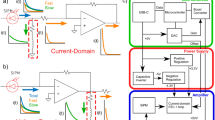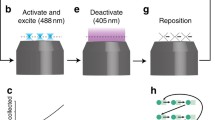Abstract
We present a multicolor multiphoton fluorescence microscope with single-photon counting sensitivity. The system integrates a standard multiphoton fluorescence microscope, an optical grating spectrograph operating in the UV–Vis wavelength region, and a 16-anode photomultiplier tube (PMT). The major technical innovation is in the development of a multichannel photon counting card (mC-PhCC) for direct signal collection from multi-anode PMTs. The electronic design of the mC-PhCC employs a high-throughput, fully-parallel, single-photon counting scheme along with a high-speed electrical or fiber-optical link interface to the data acquisition computer. There is no electronic crosstalk among the detection channels of the mC-PhCC. The collected signal remains linear up to an incident photon rate of 108 counts per second. The high-speed data interface offers ample bandwidth for real-time readout: 2 MByte λ-stacks composed of 16 spectral channels, 256× 256 pixel image with 12-bit dynamic range can be transferred at 30 frames per second. The modular design of the mC-PhCC can be readily extended to accommodate PMTs of more anodes. Data acquisition from a 64-anode PMT has been verified. As a demonstration of system performance, spectrally resolved images of fluorescent latex spheres and ex-vivo human skin are reported. The multicolor multiphoton microscope is suitable for highly sensitive, real-time, spectrally-resolved three-dimensional imaging in biomedical applications.
Similar content being viewed by others
REFERENCES
J. J. Andrew and T. M. Hancewicz (1998). Rapid analysis of Raman image data using two-way multivariate curve resolution. Appl. Spectrosc. 526, 797–807.
C. Xu, W. Zipfel, J. B. Shear, R. M. Williams, and W. W. Webb (1996). Multiphoton fluorescence excitation: New spectral windows for biological nonlinear microscopy. Proc. Natl. Acad. Sci. USA 9320, 10763–10768.
A. Miyawaki, O. Griesbeck, R. Heim, and R. Y. Tsien (1999). Dynamic and quantitative Ca2+ measurements using improved cameleons. Proc. Natl. Acad. Sci. USA 965, 2135–2140.
A. Gillenwater, R. Jacob, R. Ganeshappa, B. Kemp, A. K. El-Naggar, J. L. Palmer, G. Clayman, M. F. Mitchell, R. Richards-Kortum (1998). Noninvasive diagnosis of oral neoplasia based on fluorescence spectroscopy and native tissue autofluorescence. Arch. Otolaryngol. 12411, 1251–1258.
M. G. Mayer (1931). Ober Elementarakte mit zwei Quantensprungen. Ann. der Phys. 9(2), 273–294.
W. Denk, J. H. Strickler, and W. W. Webb (1990). Two-photon laser scanning fluorescence microscopy. Science 2484951, 73–76.
D. W. Piston, B. R. Masters, and W. W. Webb (1995). 3-Dimensionally resolved NAD(P)H cellular metabolic redox imaging of the it-situ cornea with 2-photon excitation laser-scanning microscopy. J. Microsc.-Oxf. 178, 20–27.
B. R. Masters, P.T. C. So, and E. Gratton (1997). Multiphoton excitation fluorescence microscopy and spectroscopy of in vivo human skin. Biophys. J. 726, 2405–2412.
P.T. C. So, H. Kim, and I. E. Kochevar (1998). Two-photon deep tissue ex-vivo imaging of mouse dermal and subcutaneous structures. Opt. Expr. 3(9), 339–350.
C. Buehler, K. H. Kim, C. Y. Dong, B. R. Masters, and P. T. C. So (1999). Innovations in two-photon deep tissue microscopy. IEEE Eng. Med. Biol. 185, 23–30.
B. D. Bennett, T. L. Jetton, G. T. Ying, M. A. Magnuson, and D. W. Piston (1996). Quantitative subcellular imaging of glucose metabolism within intact pancreatic islets. J. Biol. Chem. 2717, 3647–3651.
D. W. Piston, S. M. Knobel, C. Postic, K. D. Shelton, and M. A. Magnuson (1999). Adenovirus-mediated knockout of a conditional glucokinase gene in isolated pancreatic islets reveals an essential role for proximal metabolic coupling events in glucose-stimulated insulin secretion. J. Biol. Chem. 2742, 1000–1004.
B. Yu, C.-Y. Dong, P.T. C. So, D. Blankschtein, and R. Langer (2001). In vitro visualization and quantification of oleic acid induced changes in transdermal transport using two-photon fluorescence microscopy. J. Invest. Dermatol. 117, 16–25.
A. Agarwal, M. L. Coleno, V. P. Wallace, W. Y. Wu, C. H. Sun, B. J. Tromberg, and S. C. George (2002). Two-photon laser scanning microscopy of epithelial cell-modulated collagen density in engineered human lung tissue. Tissue Eng. 72, 191–202.
H. R. Morris, C. C. Hoyt, P. Miller, and P. J. Treado (1996). Liquid crystal tunable filter Raman chemical imaging. Appl. Spectrosc. 506, 805–811.
E. S. Wachman, W. H. Niu, and D. L. Farkas (1996). Imaging acousto-optic tunable filter with 0.35-micrometer spatial resolution. Appl. Opt. 3525, 5220–5226.
J. Bewersdorf, R. Pick, and S. W. Hell (1998). Multifocal multiphoton microscopy. Opt. Lett. 239, 655–657.
M. E. Dickinson, W. W. Christopher, G. Bearman, R. Wolleschensky, S. Tille, and S. E. Fraser (2002). Sensitive imaging of spectrally overlapping fluorochromes using the LSM 510 META. Proc. SPIE 4620, 123–136.
T. Haraguchi, T. Shimi, T. Koujin, N. Hashiguchi, and Y. Hiraoka (2002). Spectral imaging fluorescence microscopy. Genes Cells 7, 881–887.
Y. L. Pan, P. Cobler, S. Rhodes, A. Potter, T. Chou, S. Holler, R. K. Chang, R. G. Pinnick, and J. P. Wolf (2001). High-speed, high-sensitivity aerosol fluorescence spectrum detection using a 32-anode photomultiplier tube detector. Rev. Sci. Instrum. 723, 1831–1836.
W. Becker, A. Bergmann, C. Biskup, T. Zimmer, N. Kloecker, and K. Benndorf (2002). Multi-wavelength TCSPC lifetime imaging. Proc. SPIE 4620, 79–84.
C. Buehler, K. H. Kim, U. Greuter, N. Schlumpf, and P. T. C. So (2002). Multicolor two-photon scanning microscopy using a 16-channel photomultiplier. Proc. SPIE 4620, 217–230.
P. Tinnefeld, D. Herten, and M. Sauer (2001). Photophysical dynamics of single molecules studied by spectrally-resolved fluorescence lifetime imaging microscopy (SFLIM). J. Phys. Chem. A 105, 7989–8003.
I. Freund, M. Deutsch, and A. Sprecher (1986). Connetive-tissue polarity—optical 2nd-harmonic microscopy, crossed-beam summation, and small-angle scattering in rat-tail tendon. Biophys. J. 504, 693–712
Author information
Authors and Affiliations
Rights and permissions
About this article
Cite this article
Buehler, C., Kim, K.H., Greuter, U. et al. Single-Photon Counting Multicolor Multiphoton Fluorescence Microscope. J Fluoresc 15, 41–51 (2005). https://doi.org/10.1007/s10895-005-0212-z
Received:
Accepted:
Issue Date:
DOI: https://doi.org/10.1007/s10895-005-0212-z




